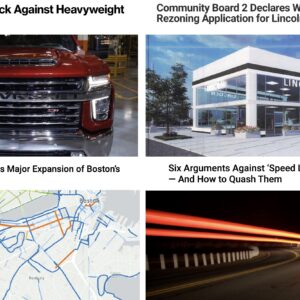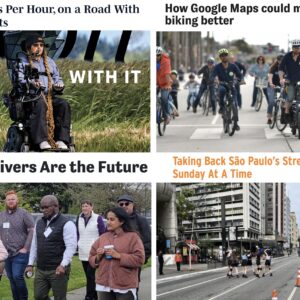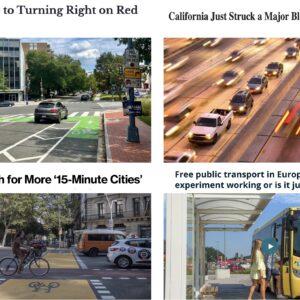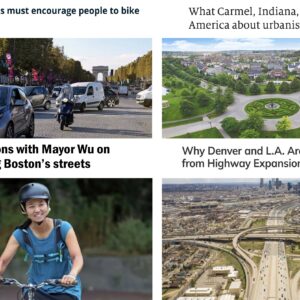Here’s the news that caught our eye this week:
– Despite a long embargo on building more bike infrastructure, ridership in San Francisco is up 58% since 2006.
– New York City’s request for proposals for a bike sharing system has sparked considerable interest in the burgeoning bike share industry.
– A British doctor conducted a study, with himself as the subject, comparing the speed of commuting to work on a new, expensive carbon bike and a heavy, old steel bike, and found no significant difference. His recommendation for improved speed: “a reduction in the weight of the cyclist rather than that of the bicycle.”
– The EU is considering whether or not to renew a 5 year tariff that is intended to protect European bicycle makers from a massive influx of Chinese bikes.
– Vélib, the bike share system in Paris, France, has had well-publicized issues with theft and vandalism. In the United States so far, neither has been a significant problem, say experts.
– The bike share system in Tehran, Iran, works a little differently than most of its European and U.S counterparts. Here’s an update on its first year.
– New data from Lyon, France, home of the first large-scale bike sharing system, shows that in the downtown core people make better time on bicycles than they do in cars.
– Last but not least on the topic of bike sharing, a software company is seeking to fund bike share programs by setting up a system that sells carbon credits earned for every mile ridden on a shared bike.
– Could better taxi design be a major factor in improving bicycle safety in cities? (Supplemental reading: A brief update on the state of the taxi industry worldwide.)
– Long Beach, California aims to be the most bicycle-friendly city in the country, but an arcane bike registration law is being used to target riders.
– Is it ethical to bicycle with your children, if driving them in a car might protect them better in a crash? Absolutely, according to The Ethicist.
– From the world of sports, a look at the sometimes substantial psychological differences between a cycling injury and a running injury.






Thanks for reading.
BikePortland has served this community with independent community journalism since 2005. We rely on subscriptions from readers like you to survive. Your financial support is vital in keeping this valuable resource alive and well.
Please subscribe today to strengthen and expand our work.
In the story about Heavy v. Light bikes they mention a Cycle to Work tax exemption. Wouldn’t that be great! Support our economy, protect the planet and get a shinny new bike! Although I do believe the out come on the light v. heavy. With traffic lights, stop signs and such the weight won’t make a difference. But fenders, light and racks will improve your comfort and safety.
Regarding the UK item about commuting on a carbon bike vs old school racing bike: I could see more value in his research question if he had evaluated the commute times between a Dutch type city bike vs a typical racing bike. This could have explored at what time point or distance the time savings of having fenders and upright slow riding format (riding in street clothes) vs fast Lycra format with shower and clothes changing time included in the commute time.
The article on light vs. heavy bikes is interesting.
I certainly think there is a point of diminishing returns when it comes to how light a bike is vs. the benefit and its cost.
My 1983 (or so) Schwinn is 35 lbs. My new alu/carbon bike is 19.5 lbs. I certainly know which one feels faster, and which one I take with me when I’m going to be doing a lot of climbing. I did the bridgepedal one year on the Schwinn, and I certainly felt more fatigued after doing 40 miles on that then I did after purchasing my new bike.
However, the cost of getting a bike lighter than my current one seemed to go up exponentially. It could have easily cost me 2x or 3x the cost, just to drop another 3 or 4 lbs of weight through a slightly lighter frame and components. It is certainly easier, and cheaper, to lose that same amount of weight riding more…
Regarding the story about San Francisco, I moved there in 2004, and the bike movement was growing. Over the six years I was there, I could not believe how the number of cyclists swelled on the streets. I always had to pinch myself, and ask, “Is this really happening?” I certainly think economic conditions, a ‘transit first’ policy, and people realizing that a 10-20-minute commute by bike is not such a bad thing has helped increase numbers. Now, as they embark on painting more lanes, perhaps the numbers will continue to grow. “If you build it, they will come,” eh?
What’s the advantage of a lightweight carbon bike when you have to carry around a 20 lb. anchor chain to keep it from getting stolen?
Lock up a bike like that? HA! That’s what you have an old beater for. A nice bike like that is for “riding”, not for going to the store or the bar.
The light vs. heavy bike commute time study is silly. Did the guy monitor his pulse to ensure the same effort on both bikes? If not, he could have been subconsciously pushing harder on the heavy bike to go a speed he is more used to on the light bike.
That brings up another point. A fit person may be able to “push” their heavy bike to a point that commute time is similar to a light bike, but that might create the need to shower, throwing off the time comparison, when less effort for equal speed on a light bike may not require a shower.
Also, hilly vs. flat, and consistent pedaling vs. lots of stops both increase or reduce the advantages of a light bike.
Many factors apparently not considered in this article and/or study.
Lots of good points have already been made about the ‘heavy’ vs light bike. I’d only add that his ‘heavy’ bike didn’t look the least bit heavy in the photo. Folks who pursue light/efficient/new think everything that isn’t whatever the cutting edge is defined to be is automatically obsolete: heavy/inefficient/old. This is not a helpful way of structuring the debate.
Heavy vs light bike
“It’s better to pay less to lose pounds than to pay more to lose grams.”
Re: cycling injury. I had a nasty fall from a bike. I was riding down on short steep road. A van backed up from a parking spot. I had to brake really hard to avoid the collision. The bicycle flipped over. I landed and slided the road on front. My shoulder got hurt for a long time. No broken bones. I did not ride it again for a while. Finally I overcame my fear of cycling. Now I go to work by bike regularly. I think I am more cautious than before.
I low-sided when I was about 12, leaning way over at speed to go up a driveway. I wasn’t hurt significantly, but have never been able to bring myself to lean over that far since.
I had a crash just a few months ago, was in the hospital for five days, and I got back on the bike the second I could (when I got my new glasses) because I was worried that otherwise I’d be too scared to start biking again.
Re: Cycling Injury. I crashed hard on July 21st, and broke my collarbone. I had surgery on August 2nd, and was riding outside again by the beginning of September. I never considered giving up riding, but wondered how I’d do going downhill at speed. Didn’t really bother me as much as I thought it might. My particular crash was completely self-inflicted, so I’m sure (as the article states) that has something to do with how easily I was able to resume cycling.
I totally believe the speed claims, but I didn’t see mention of comfort when considering a carbon bicycle. After riding my steel bike to work on Portland streets, I can tell you my body feels the difference. Every patched pothole, every bus tire rut, every fast stop, each roughly paved block, and so on.
Re: the L.B. cycling tax, could you have a more arcane and difficult to pay tax? You can only pay your vehicle sticker tax at a fire station between 0900 and 1200 on a Saturday or Sunday if the person in charge of collecting the fee isn’t out doing something more important like saving lives or property. That makes even less sense than putting the pay window in the basement of City Hall at the bottom of a broken staircase, in a dis-used lavatory under a sign that says “Beware of Leopard”. I mean seriously this is even stupider than a Douglas Adams’ joke about stupid bureaucracy. And they don’t even tell the people that sell the product that the product is taxed now?
Regarding the Paris, France bike sharing program and their rate of theft vs. bike sharing programs in the US, crime rates in America pale in comparison to those in Paris. Paris is easily one of the largest crime capitals of the world, so I hardly find their findings surprising.
nice bike or beater, I have noticed a freshly greased and adjusted set of wheel bearings has more impact on speed than frame weight. My $.02
I totally agree Joe, ever since I discovered 3 ‘n 1 oil at the sweet age of 5. My balloon tire bomber ran so sweet after a lube! And it probably weighed damn near half my own weight! Still, no one could catch me! hahahaha (the sound of pure unadulterated freedom!)
I wrote to the woman who wrote the last article, pointing out that getting back on a bike after an accident is different when you ride for transportation instead of sport. She agreed and said that she was lucky, she had two sports (cycling and running) and her husband just had cycling, and that made a difference as well.
Oh, and heavy vs. light bikes: there’s more going on, usually, than weight. My 1961 Raleigh is slower than my 1985 Miyata. It’s not just weight–the Raleigh has an upright posture (which makes headwinds unpleasant), shorter cranks, and totally different gearing (3-speed hub gear set fairly low compared to 18-speed derailer). I am much slower on the Raleigh, obviously. Hell, if I try to pedal at my usual cadence, the seat bounces!
New favorite acronym, courtesy of the heavy bike vs. light bike article: Middle-Aged Man In Lycra – MAMIL !!
Word has it that this taxonomical class has the characteristics of having fur and/or air, breathing air, having vertebrae, and (for the most part) not being able to recognize the meaning of red octagons. J/K…
I’m glad we don’t have bicycle tax stickers. I just peeled all mine off to save weight.
I think Todd is on to something. Does Anyone know at what distance having a fast bike with lycra is quicker than a slow bike with street clothes? Would shower/change time need to be included?
Re bike-share: In Iran, don’t they chop off your hand if you steal something?
Weight saving tip: Remove your seat to save some precious grams!
http://www.bmj.com/content/341/bmj.c6801/F1.large.jpg
sneakers, a single 39 ring on the old bike, and a double on the new bike.
i think its time groves learned how to ride the big ring.
i’m certain he has a second chainring on his old bike. and how do you know it’s a 39t? unless you found out specifically that’s what he has, you’re just guessing?
and i always ride in sneakers. big whoop.
ok my bad. the newer bike appears to have a larger chain ring. and a larger chain ring means a faster commute (for fit bikers).
imo, riding in sneakers on a nice road bike is like riding in flip flops on a hybrid. its a valid lifestyle choice but betrays a lack of interest in speed and efficiency.
I’ve read several articles that say there really isn’t much speed gain in riding clipless. Plus, I think they’re kinda stupid if you do most of your riding in town.
I have plastic toe cages (no straps), but that’s mostly so I can pedal hard in the rain/impractical shoes, without worrying about my feet sliding off the pedals. I’ve ridden up to 90 miles a day on tour, carrying all my stuff over the Cascade Range, in casual shoes, and never wanted clipless pedals.
i should note that i meant to emphasize that a rigid bike shoe makes a huge difference in pedaling efficiency and foot health/comfort versus a floppy sneaker.
toe cages are also a good solution but i disagree that clip in riding do not make sense in the city. i personally find that step in cleats make riding more comfortable than toe cages. they also force your feet into correct alignment with the crank and help reduce stress injuries. clipless pedals are also safer than using cages because you are not stuck going down with your bike.
Good cycling shoes and clipless pedals definitely allow me to use my leg muscles much more efficiently than do street shoes, sneakers and pedals without retention. For general purpose riding, speed, or at least…top speed isn’t the critical advantage good shoes and clipless offer, because almost any shoe, even bare feet can get a cyclist up to a good general purpose cruising speed. For the kind of riding I do, pedaling that’s easier on my legs is the advantage of clipless.
For a year though, I rode Shimano clipless mountain pedals with just some old Brooks running shoes I had around. The combination worked, and was convenient to be able to hop off the bike and walk easier than even with recessed cleat cycling shoes. Ultimately though, I couldn’t escape realizing that the running shoes were wasting a lot of my energy.
Re: Tehran Bike sharing program
Wow, I love how humorous it is that women are excluded from being able to borrow the bikes: “women can only be green with envy because they not allowed to participate in this bike-sharing!”
Hahahahahahaha, discrimination is funny!
Yeah, that part of the article really bugged me too. The fact that half the population can’t use them should be a pretty big deal.
Yikes, looks like I need to brush up on my speed reading. I completely missed that part of the Tehran story. Thanks for calling them on it, ERN. That is indeed, not really hilarious.
http://bikecalculator.com/
will let you figure out for yourself how much faster you’ll be on a lighter bike. The short answer is indeed “not very” 🙂 For instance:
“How does weight influence these curves? If you lost 10 lbs (about 5%), you would be able to go about 5% faster on the steepest hills and 0.4% faster on the level; you’d go about 2% slower on the downhills.
Over a simulated 20-mile closed-circuit ride with a variety of grades, a 10-lb difference produced a 33 second difference. (You can do this sort of calculation with one of the “Six Segment” calculators.) This may or may not seem significant in the context of a time trial. On the other hand, there were two hills on this simulated route where the heavier rider falls back 14 seconds. That is, about 200 feet back and well-dropped. A two-lb difference that you can buy at a bike shop for $500 amounts to only 7 seconds on this circuit, but again, a two-lb penalty can mean cresting a hill 50 feet behind your better-sponsored buddies. ”
Unless you’re racing, I don’t think that 33 second difference is going to matter 🙂
The way some people commute, it would certainly seem as if it were a race!
for category 6 racers it always matters.
It may be true that there is no difference commuting on an older 25 lb. road bike and a new carbon fiber bike, it is not true that commuting on a 40 lb. beach cruiser would be the same as commuting on 25 lb. road bike. The beach cruiser is going to be much slower, although it will be more of a workout.
I agree that the best way to go faster is to lose weight.
I agree – 25 lbs is hardly a weight that will truly affect commuting times, IMHO. Many new bikes will approach that weight once you add water bottles and a saddle bag with some flat repair tools.
the whole premise of the article was a bit of a “fred” joke.
a very expensive cf bike is 15-16 lbs.
a very expensive steel bike is 18-19 lbs.
There’s a ton of research showing what’s most important for fast riding (and, by the way, the UK prof was not riding fast — only about 15 mph). Here’s how it breaks down:
1) Aerodynamics. If you’re going more than about 10-15 mph aerodynamic drag is the largest resistive force. Commuters are hardly dressed to minimize drag, which is probably one reason the chap from the UK rode so slowly.
2) Rolling friction. Tire friction is a function of a bunch of things, including tire diameter, pressure, and load. Ordinarily it’s less than 10% of the work load for anyone trying to go fast (aerodynamic loading is the other 90%). Road bikes have faster (i.e., narrower and higher pressure) tires than most commuter bikes.
Weight is a component of the rolling friction, and the least expensive way to cut down on weight is by dropping a few pounds.
Components are another issue. The components on a commuter bike give transmission efficiencies in the mid 80% range. Those on a good high-end road bike (depending on the gear) can be in the mid to high 90% range.
Finally, it depends on the terrain. If the terrain is flat then weight isn’t nearly as big of an issue as when the terrain is hilly. My work commute, for example, takes me from Saint Helens (Or) to Hillsboro (34 miles). I have roughly 2,500 feet of hills each way. It would be *huge* extra effort for me to take my 25 pound hybrid instead of my 15 pound carbon bike.
Here’s a really good book on the subject:
http://www.amazon.com/High-Tech-Cycling-Edmund-R-Burke/dp/0736045074
Duwayne Anderson